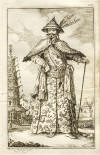
[This image does not actually portray the Historical Long
Rider. It appears in the Dutch translation of Bell's book. The Guild
continues to search for an image depicting the
Long Rider and will publish it when found.] |
Dr. John Bell
was a Scottish doctor who journeyed from St. Petersburg, Russia, riding
across Siberia, before completing his sixteen-month journey at Peking, China
in 1717. During his journey Bell met the Dalai Lama of Tibet and
observed the equestrian practices of the people he met along the way.
|
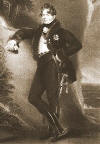 |
Sir Robert Ker Porter
was a celebrated English artist and explorer who travelled to Spain,
Portugal, Russia, Finland, Sweden and South America. In addition to being
knighted by Great Britain’s Prince Regent and the King of Sweden, Sir Robert
was awarded the order of the Lion and the Sun by the Shah of Persia. His
most celebrated equestrian journey began in 1817 when he rode from
St. Petersburg, Russia to Teheran, Persia. |
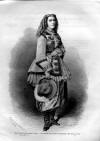 |
Even though she lived and rode in the adventure-soaked nineteenth century,
there were few women who could match the amazing life and exploits of
Catherine de Bourboulon. Born in Scotland in the 1820s, Catherine
Fanny MacLeod was taken by her mother to live in the United States at an
early age. Later the young traveler journeyed on to Mexico. There MacLeod
discovered Phillipe de Bourboulon, a Frenchman who not only became the love
of her life but harboured a spirit as wild as her own.
Soon after they married the newlyweds left Mexico, arriving in China in
1849. They lived among the splendours and intrigues of the Chinese imperial
court for ten years before deciding it was time to return to Europe. Then
Catherine made an amazing suggestion. Rather than embarking on the first
ship bound for France, she and Phillipe would instead ride 19,000 kilometres
(11,800 miles) through some of the most desolate and dangerous portions of
Asia.
“Shang-Haï à Moscou” is the account of this amazing journey undertaken by
the young lovers on horseback from 1859 to 1862. Written in French
from diaries Fanny kept during the journey through Mongolia, Siberia and
Russia, the book is compiled from a series of magazine articles published in
Paris during the mid-nineteenth century. Alas, Catherine MacLeod de
Bourboulon died soon after her return to Europe. She was only 38 years old.
Much of her exciting story was later plagiarized by Jules Verne for his
famed Cossack novel, “Michael Strogoff.”
|
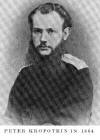 |
Russian anarchist, Peter Kropotkin, rode across Siberia from Irkutsk
to Kyakhta in 1864. Though he became one of the forefathers of the
Russian revolution, Kropotkin never forgot this great equestrian journey he
made as a young man. It was a "long, circuitous route, across mountains
7000 to 8000 feet high. I once travelled along this track, greatly enjoying
the scenery of the mountains, which were snow-glad in May, but otherwise the
journey was really awful. To climb eight miles only, to the top of the main
pass, Khamar-daban, it took me the whole day from three in the morning till
eight at night. Our horses continually fell through the thawing snow,
plunging with their riders many times a day into the icy water which flowed
underneath the snow crust," wrote Kropotkin. |
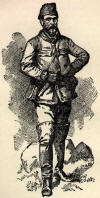 |
American Long Rider Januarius MacGahan rode from Fort Perovsky,
Russia, across the Kyzil-Kum Desert to Adam-Kurulgan ("Fatal to Men"),
Kyrgyzstan in 1873. |
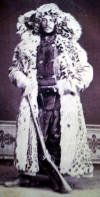 |
Swiss Long Rider Henri Moser was given permission to undertake an
unprecedented equestrian exploration across Central Asia. Setting off in
1882, the young watch-maker turned equestrian explorer left St.
Petersburg bound for Tashkent. He then rode on to Samarkand, Bukhara and
Khiva, made his way to Tehran, crossed the Caucasus Mountains and finally
emerged at Istanbul in 1883. |
 |
In April 1889 Mikhail Asseyev departed on a journey from Lubny,
Russia to the newly-erected Eiffel Tower in Paris, France. He used two
mares, Diana an Anglo-Don, and Vlaga, a Novorossisski. Asseyev travelled “à
la Turkmène” – that is to say, he rode one horse in the morning and the
other in the afternoon, the led horse being completely “naked” – no pack, no
weight. For, as all Long Riders understand, the horse’s enemy is not the
kilometres but the kilograms. Using this system Asseyev averaged 100
kilometres a day. After riding more than 3,000 kilometres (1,850 miles),
when Asseyev arrived with his two mares beneath the Eiffel Tower, the
Society for the Protection of Animals decorated him with a special gold
medal because his horses were in excellent shape after such a long journey. |
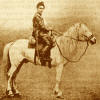 |
In November 1889 Dmitri Peshkov left his garrison's outpost of
Blagoveshchensk in the far east of the Russian Empire on his Siberian horse,
Seriy. After many amazing adventures, they arrived in St. Petersburg at the
Czar’s court having covered more than 8,800 kilometres (5,500 miles) in
temperatures sometimes as low as minus 60 degrees Fahrenheit. In recognition
of the hardships endured by Seriy, the Siberian horse was adopted by the
family of the Czar. |
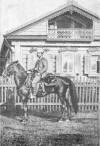 |
American Long Rider Thomas Stevens rode 1,500 kilometres (930 miles)
from Moscow, Russia, to Sevastopol on the Black Sea in the summer of 1890.
Stevens was mounted on a Hungarian Furioso horse named Texas. During the
journey, Stevens met Dmitri Peshkov, who was nearing the completion of his
ride to St. Petersburg. |
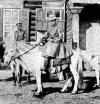 |
English Long Rider Kate Marsden rode
3,200 kilometres (2000 miles)
across
Siberia in 1890, to visit the leper colonies of
Yakutsk. |
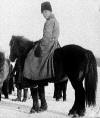
|
Prince Galatzin
of Russia made a 19,300 kilometre (12,000 miles) ride through Russia,
Turkestan and Tibet. A descendant of one Russia’s noblest families,
according to an interview granted to the Los Angeles Times on November 23,
1893, Galatzin had just arrived by ship in San Francisco, after having
completed an equestrian journey of tremendous proportions.
Galatzin set off from St. Petersburg in May, 1890, after having been
commissioned by Czar Alexander III to undertake a scientific and diplomatic
mission, so as to collect specimens of minerals and plants, as well as to
make barometric observations. The prince travelled with a mounted escort
provided by the Russian ruler.
“On reaching the Tibetan highlands we could barely breathe. I soon found
that it was highly dangerous to sleep on the ground, not because of the cold
but because of the possibility of the heart ceasing to beat. Though one
might not notice at first, his lungs soon grew too cramped to afford free
breathing and the sleeper would grow black in the face, while his heart
would flutter like a wounded bird. Several of my men came near losing their
lives, so to obviate the great danger of dying while trying to gain a little
rest, we were forced to sleep in a sitting posture,” Galatzin recalled.
As they proceeded, the lack of oxygen caused the Russians to have delusions.
“The thin air caused us to move very slowly and become the victims of
strange hallucinations. One day some of my men said that they had seen two
queer men in white who said they were ghosts. All of us felt very
light-headed and strange. Our hearts fluttered as though they might suddenly
stop and we were weak as though we were recovering from a serious sickness.
We found we must eat no meat nor drink spirits, as these increased the
beating of our hearts. Sugar was good but a single cup of coffee in that
thin air could kill a man.”
Though he had survived the journey, the forty-six-year-old nobleman was
reported to be in frail health. |
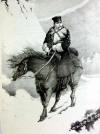 |
In February 1892 a Japanese samurai named Baron Yasumasa Fukushima
began a legendary journey. Having been serving as Japan’s military attaché
to Berlin, when his tour of duty ended, instead of taking the ship home to
Tokyo Fukushima decided to travel overland on horseback. His equestrian
journey of 14,500 kilometres (9,000 miles) became a legend in Japan. The
Emperor hailed him as a hero, and adopted his three horses in the name of
the Japanese nation. The ragged clothes of the Long Rider, and his whip,
were put in a temple where they are still venerated. |
 |
Alexander Nikolaevich Kenik,
an officer in the Russian cavalry, made a journey in 1895. Mounted on
his stallion, Irkut, the lieutenant set off on June 14, from the village of
Duderhof (about 30 kilometres from Saint Petersburg). After riding 7,000
kilometres (4,300 miles), Kenik and Irkut arrived at Chita, in southeast
Siberia. The 155 day ride was recounted in books written by the Russian
author Nikolai Amvrosiyevich Kotlyarevsky and the American travel writer W.
H. Jackson. |
 |
Valdemar Langlet
was a Swedish Long Rider who made an equestrian journey across Russia in
1898. He made the ride across Russia in order to meet the famous author
and enthusiastic horseman, Count Leo Tolstoy. The two men were both
advocates of Esperanto, the international language which many believed would
help usher in an age of peace in Europe. |
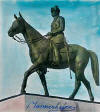 |
In 1906 a Finnish cavalry
officer Baron Carl Gustaf Mannerheim undertook a 14,000 kilometre
(8,700 miles), two-year expedition from Andizhan in Russian Turkestan to
Peking, China.
Mannerheim had served in the Imperial
Chevalier Guard until 1904. An expert rider, one of his duties was buying
horses for the army. In 1903, he was put in charge of the model squadron in
the Imperial Chevalier Guard and became a member of the equestrian training
board of the cavalry regiments.
Mannerheim volunteered for active
service in the Russo-Japanese war in 1904. He was transferred to the 52nd
Nezhin Dragoon Regiment in Manchuria, with the rank of Lieutenant-Colonel.
He was promoted to Colonel for bravery in the Battle of Mukden in 1905 and
briefly commanded an irregular unit of Hong Huzi, a local militia, on an
exploratory mission into Inner Mongolia
When Mannerheim returned to St. Petersburg, he was asked to undertake a
journey through Turkestan to Beijing s a secret intelligence-officer.
Disguised as an ethnographic collector, Mannerheim started from the terminus
of the Trans-Caspian Railway in Andijan in July 1906. He first trekked to
Khotan and then headed north into the Tian Shan range. After arriving at
Urumqi, he headed east into Gansu province and followed the Great Wall of
China. From Lanzhou, Mannerheim headed south into Tibet. After riding 14,000
kilometres (8,700 miles) he arrived in Peking in July 1908. |
 |
Alexandra Kudasheva
holds a special place in Long Rider history. In 1910 she rode her
Manchurian horse, Mongolika, 20,000 kilometres (14,500 miles) from Harbin,
China to St. Petersburg, Russia. Czar Nicholas II then asked the equestrian
explorer to ride his valuable Arabian stallion on another journey from
Vladivostok to St Petersburg. “Queen
of the Cossacks”
recounts how Kudasheva then became a decorated hero during the First World
War but met a tragic end. |
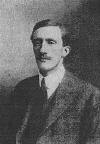 |
In 1910, English Long Rider Douglas Carruthers was determined
to see Dzungaria, an ancient Mongolian kingdom which lay between Siberia and
Mongolia. The obscure realm had been named for the Dzungars, the left (züün)
hand (gar) of Genghis Khan’s army.
But despite his scientific credentials, the Long Rider had to contend with a
hostile Russian government that disbelieved in Carruthers purpose. It was
only after Carruthers had appealed to the Governor-General of Siberia that
the proper paperwork was produced and the traveller was permitted to depart
across Russian territory, bound for faraway China, via Dzungaria. The
resultant trip took Carruthers across 8,000 kilometres (5,000 miles) of
trackless forest, insect infested taiga, freezing steppes and dreary
deserts.
|
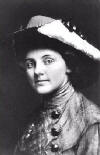 |
Though born in the United States, Anna Louise Strong became an early
advocate of the USSR. Joseph Stalin was so pleased with this American
convert that he encouraged her to visit the far-flung corners of the
communist country. Mounted on her horse, Strong Boy, she accompanied a group
of Soviet geologists as they rode into the seldom-seen Pamir Mountains of
Tajikistan in 1928. |
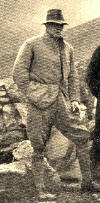 |
In 1929 American Long Rider Negley Farson rode from Utsch
Kalan, Karachay to Batalpaschinsk, Russia via the Caucasian mountains.
Farley used two Tartar horses named Kolya and Marusha. |
 |
Starting in 1988 Russian Long Rider Vladimir Fissenko spent
five years riding from the bottom of the world, Patagonia, to the top of the
world, Alaska. The
30,600 kilometre (19,000 mile) journey went from Ushuaia, Tierra del Fuego,
Argentina to Prudhoe Bay, Alaska. |
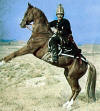 |
In the last days of the Soviet Union an impassioned young Turkmen believed
the Akhal Teke was in danger. Geldy Kyarizov mounted his Akhal Teke
on June 1, 1988, determined to ride from Ashgabat to Moscow. His
4,300 kilometre (2,671 mile) journey took him through what is today
Turkmenistan, Uzbekistan, Kazakhstan and Russia. He was forced to ride 370
miles through the scorching heat of the Kara Kum Desert. |
 |
French Long Rider Jean Louis Gouraud rode from Paris to Moscow in
1990. The journey was made using
two French Trotters named Robin and Prince. Upon arriving at Red Square, the
horses were given to Raisa Gorbechev as a gift. |
 |
Swiss Long Rider Catherine Waridel departed in 1992 on a 5,000
kilometre (3,000 mile) journey that took her from Soudak in the Crimea,
across Russia and Kazakhstan, to Ulaan Batar in Mongolia. |
 |
Polish Long Rider Tadeusz Kotwicki
rode his Akhal Teke 4,000 kilometres (2,500 miles) from Jambyl, Kazakhstan
to Moscow, Russia in 1992. |
 |
In 1995 English Long Rider Basha O’Reilly rode from Alexikovo,
Russia to Denston, England, on a Volga Cossack stallion named Count Pompeii. |
 |
Italian Long Riders Dario Masarotti and Antonietta Spizzo
departed in 1997 on a journey from Premariacco, Italy across
Slovenia, Hungary, Ukraine and Belarus to Russia. They rode an Arab mare
named Sebiba and an Anglo-Arab gelding called Terek. |
 |
In August 2007 Jing Li began an epic journey on horseback.
Starting at Votkinsk, Russia, his route took him through the Ural
Mountains, which serves as the Continental Divide between Europe and Asia.
His arrival in Siberia coincided with the onset of winter.
Severe weather halted his journey for three months. Finally, after eighteen
months in the saddle, and having ridden 9,000 kilometres (5,592 miles), Jing
Li reached the capital of China. |
 |
In 2010 Dutch Long Rider Michel Jacobs rode 2,400 kilometres
(1,500 miles) from Amsterdam, Holland to St. Petersburg on an Andalusian
mare named Lista. |
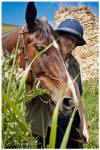 |
English Long Rider Michael Pugh rode from Moscow to Sighisoara,
Romania in 2014. |
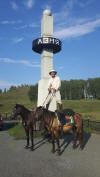 |
In the company of his two Zemaitukai horses, Azuolas and Ceklis, Lithuanian
Long Rider Vaidotas Digatis set off in 2016 on a 3,000
kilometre (1800 miles) journey that took him from Laukuva, Lithuania, over
the Ural Mountains, to Surmenevsky, in the district of Chelyabinsk. |
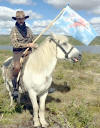 |
New Zealand Long Rider Ian Robinson made a solo journey through the
taiga in the Sakha Republic, or Yakutia, in Siberia, in 2106.
He rode a Yakut horse named Katchula. |































